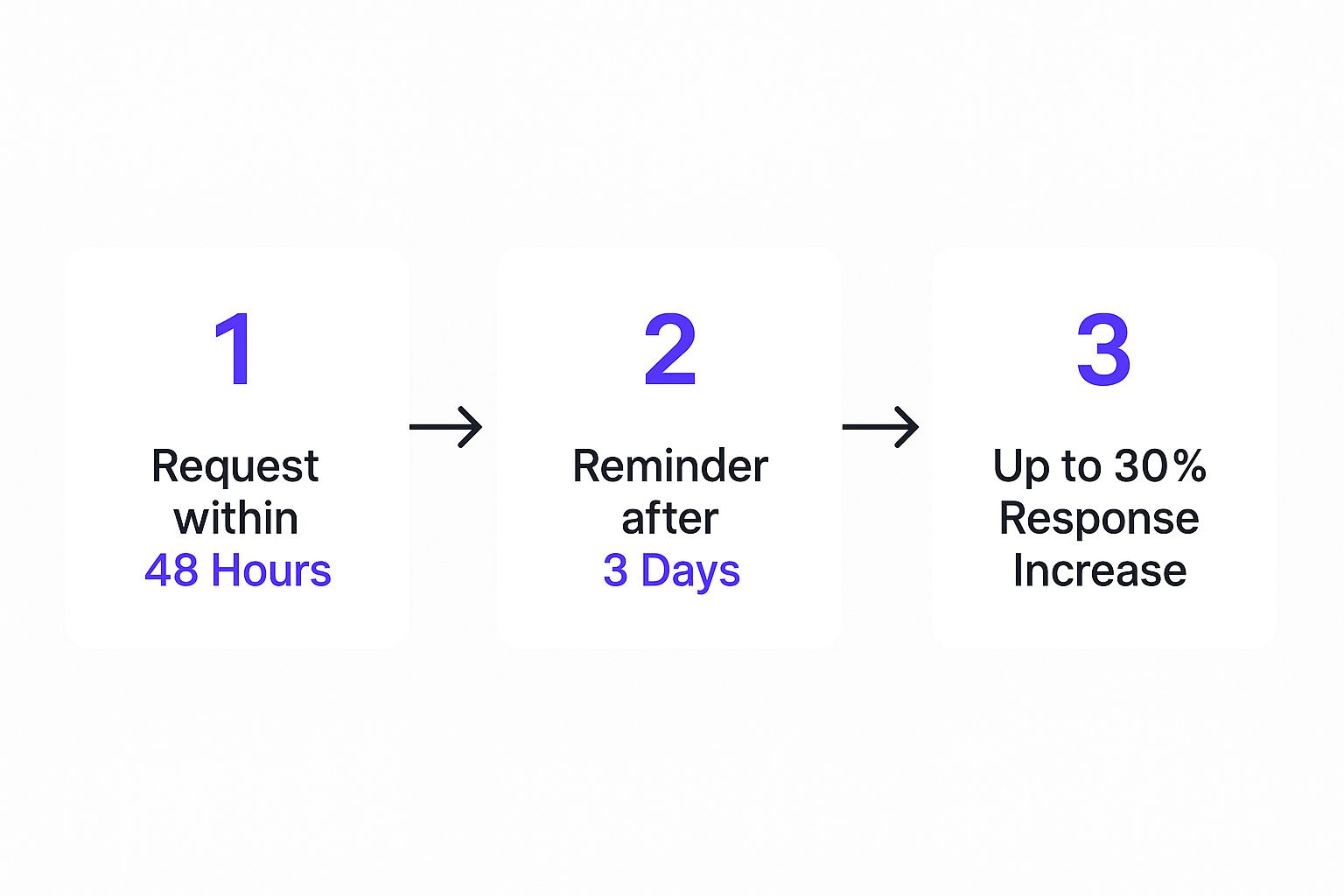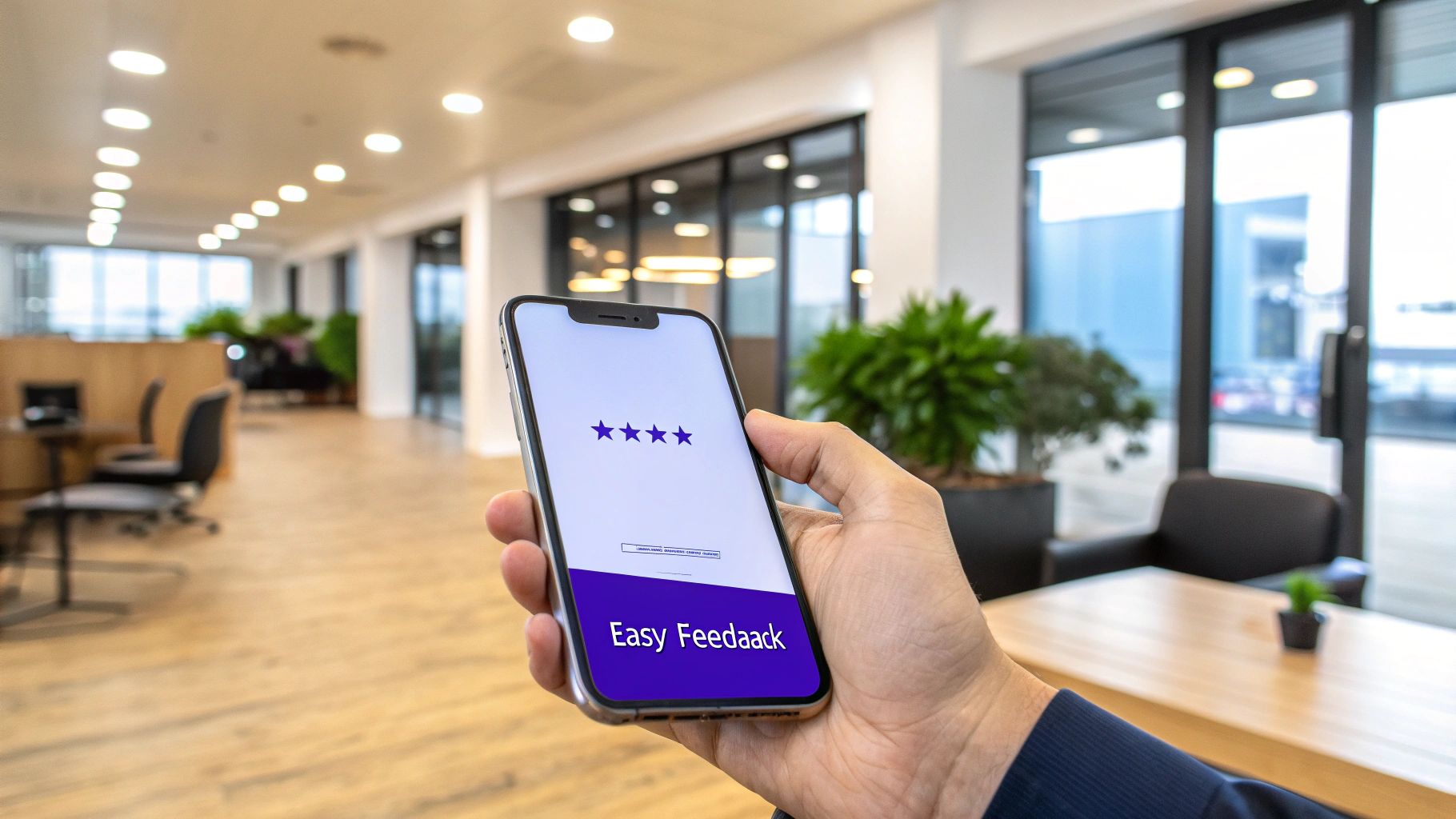How To Get Customer Testimonials That Actually Convert
Master how to get customer testimonials with proven strategies from industry experts. Turn satisfied customers into powerful advocates.
Posted by
Why Customer Testimonials Are Your Secret Weapon
Customer testimonials are more than just praise; they're a powerful tool for business growth. They go beyond simple reviews, tapping into the psychology of trust and social influence. Let's explore why testimonials are key to convincing potential customers and improving your bottom line.
How Testimonials Build Trust and Drive Sales
Think of testimonials as amplified word-of-mouth marketing. They share genuine stories of how your product or service has helped real people. This authenticity resonates with potential customers, who are often wary of traditional advertising. Testimonials bridge the gap between marketing claims and tangible results, making your brand more relatable and trustworthy. For example, a small business owner sharing their success with your Squarespace website carries more weight than a generic advertisement about Squarespace features.
This builds credibility and fosters a sense of community around your brand. Testimonials offer social proof, demonstrating that others have benefited from your offerings. This is especially important in today's market, where consumer decisions are heavily influenced by shared experiences. In fact, gathering customer testimonials is crucial for establishing trust. Statistics show that 72% of customers trust a business more after reading positive reviews and testimonials. This highlights the substantial impact of testimonials on customer perception and buying choices. Furthermore, displaying these testimonials can increase sales by an impressive 270%. For more detailed statistics: Learn more about the power of testimonials.
Addressing Customer Skepticism Throughout the Buying Journey
Customer skepticism is a normal part of the buying process. Testimonials counter this skepticism, addressing doubts and objections at every stage. From initial awareness to the final purchase decision, testimonials can reassure potential customers about your product or service's value and effectiveness.
Consider the customer journey:
- Awareness: Testimonials grab attention and spark interest in your brand.
- Consideration: They address specific concerns and offer solutions to potential problems.
- Decision: Testimonials provide the final push, reinforcing the value proposition and encouraging conversion.
This means integrating testimonials throughout your marketing materials, from your website to your social media presence, can significantly influence purchasing decisions.
Outperforming the Competition with Customer Voices
Businesses that actively collect and display customer testimonials often outperform their competitors. This is because testimonials create an emotional connection that standard marketing copy can't match. They offer real stories, relatable experiences, and tangible results, humanizing your brand and making it more approachable.
Additionally, testimonials offer valuable insights into what resonates with your target audience. By analyzing the language and themes within testimonials, you can better understand your customers' needs and motivations. This allows you to refine your messaging and tailor your Mailchimp marketing campaigns for greater effectiveness. Ultimately, this leads to increased customer engagement, higher conversion rates, and stronger brand loyalty.
Understanding What Makes Customers Want To Share

Asking for customer testimonials is crucial for any business. However, the timing and approach you take can make all the difference. It's a common mistake to ask at the wrong time or in a way that feels unnatural. This section explores why customers share their experiences and how to identify enthusiastic customers. We'll also look at creating an environment where providing testimonials feels organic.
Identifying Your Biggest Fans
Not all satisfied customers are the same. Some are happy with their purchase, while others become true advocates for your brand. These brand evangelists are eager to share their positive experiences. Identifying them is the first step in getting valuable testimonials.
Look for customers who:
- Regularly engage with your brand on social media.
- Leave positive reviews or comments on your website or blog.
- Actively participate in your community forums or events.
- Refer new customers to your business.
These behaviors signal a high level of satisfaction and a willingness to recommend your brand. For instance, a customer consistently praising your product on Twitter is more likely to give a compelling testimonial. This is compared to someone who made a single purchase. Check out our guide on how to master your testimonial marketing strategy.
The Power of Reciprocity and Timing
Reciprocity plays a significant role in customer relationships. When you provide excellent service or go the extra mile, customers are more likely to reciprocate. They often do this by sharing their positive experiences. Building strong customer relationships is therefore essential for obtaining testimonials.
Timing also matters. Asking for feedback immediately after a positive interaction often yields the best results. This might be after a successful product implementation or a resolved customer service issue. However, waiting too long can decrease the customer's enthusiasm.
Reading Customer Signals and Creating a Sharing Environment
Recognizing subtle cues that indicate a customer's willingness to share is vital. Pay attention to positive language, enthusiastic expressions, and unsolicited praise. These are all indicators that a customer might be open to a testimonial request.
Creating an environment where sharing feels natural and appreciated is also key. This can involve:
- Regularly soliciting feedback through surveys and polls.
- Actively responding to customer comments and reviews – both positive and negative.
- Publicly showcasing customer testimonials on your website and social media channels.
- Making the testimonial submission process simple and convenient.
By creating a culture of open communication and appreciation, you encourage customers to share their stories. They then become valuable advocates for your brand. This approach not only helps in gathering testimonials. It also strengthens customer relationships and builds trust.
Customer testimonials are not just about trust; they also influence purchasing decisions. Studies reveal that 95% of consumers read online reviews before buying. Reviews influence 32% of purchases – more than discounts or coupons. Find more detailed statistics here: Discover more insights about customer behavior. You might be interested in: How to master your testimonial marketing strategy. This highlights the importance of actively soliciting and showcasing testimonials. It drives sales and builds a strong online reputation. By understanding what motivates sharing, you can create a system where testimonials flow naturally, turning satisfied customers into powerful brand ambassadors.
The Right Way To Ask For Testimonials
Asking for testimonials doesn't have to be a stressful experience. In fact, done right, it can build stronger relationships with your customers and offer powerful social proof for your business. Let's explore some proven methods to get positive feedback, craft authentic requests, and make sharing a breeze for your clients.
Timing Is Everything: When to Make Your Request
Knowing when to ask for a testimonial is key. Asking too early can seem pushy, while waiting too long could mean missing out on that initial enthusiasm. A good rule of thumb is to make your request within 48 hours of a positive interaction. This could be after a successful product delivery, the completion of a project, or the resolution of a customer service issue.

This infographic shows a simple but powerful follow-up process. Sending a reminder just three days after your initial request can dramatically boost your response rate – by up to 30%. This highlights the importance of a timely and persistent approach. For more insights, check out this helpful resource: How to master asking for testimonials.
Personalize Your Approach: Making It Feel Genuine
Generic requests often go unnoticed. To improve your chances of receiving a testimonial, personalize your message. Use the customer's name and mention their specific experience with your product or service.
For example, instead of a bland "We'd love a testimonial," try something more personal like, "We were so happy to help you achieve [specific result] with [product name]. We'd appreciate hearing more about your experience." A positive customer experience starts with a great onboarding process. Learn more about effective customer onboarding: onboarding a customer successfully.
Choose the Right Channel: Meeting Customers Where They Are
Different communication channels are effective for different customer groups. Email is often the easiest, but consider phone calls for important clients or even personalized video messages for building stronger relationships. Choosing the right method shows respect and makes a positive response more likely.
Simplify the Process: Making It Easy to Share
Make providing testimonials as simple as possible. Offer various formats like written feedback, short video clips, or audio recordings. Clear instructions and templates can also be helpful. The easier the process, the more likely customers are to participate.
To help illustrate the different approaches and their effectiveness, let's take a look at this comparison table:
Testimonial Request Methods Comparison A comparison of different approaches to requesting testimonials, including response rates, effort required, and best use cases
| Method | Response Rate | Effort Level | Best For | Timing |
|---|---|---|---|---|
| Medium (20-30%) | Low | General requests, follow-ups | Within 48 hours of positive interaction | |
| Phone Call | High (40-50%) | Medium | Key clients, personalized feedback | 1 week after positive interaction |
| Video Message | High (50-60%) | High | Building relationships, special occasions | After achieving a significant milestone |
This table demonstrates how personalizing your outreach and choosing the right channel can significantly impact your response rate. While video messages require more effort, they can foster stronger connections and lead to higher quality testimonials.
Overcoming Objections and Handling Hesitation
Some customers might hesitate to provide a testimonial. Address their concerns with empathy and offer reassurance. Explain how their feedback can help others make informed decisions and contribute to improving your product or service. This transforms a request into a collaborative opportunity, strengthening the customer relationship and fostering loyalty.
Crafting Questions That Get Powerful Testimonials
The key to compelling customer testimonials lies in asking the right questions. Instead of generic feedback, aim for detailed stories, quantifiable results, and emotional impact. This transforms testimonials into powerful sales tools.
Focusing on Specific Results and Quantifiable Outcomes
Go beyond simple satisfaction and explore the concrete benefits customers experienced. Instead of asking, "Were you happy with our service?", try "What specific results did you achieve using our product?" or "How much time or money did you save?"
For example, if you sell project management software like Asana, ask, "How many projects did you successfully complete using Asana last quarter?" This encourages tangible evidence of your product's value. Quantifiable outcomes make testimonials more impactful, especially for data-driven prospects.
These concrete examples strengthen your marketing efforts. They give potential customers a clear understanding of the value they can expect.
Unveiling the Emotional Transformation
Understanding your customers' emotional journey adds depth and authenticity to testimonials, allowing deeper connections with potential clients. Ask questions like, "How did our product make you feel?" or "How has using our service changed your daily operations?"
For a business selling mindfulness apps like Calm, a powerful question could be, "How has using Calm impacted your stress levels and overall well-being?"
Capturing emotional transformation paints a vivid picture of your product's positive impact. This resonates deeply with prospective customers, emphasizing intangible benefits alongside quantifiable results.
This well-rounded view of the customer experience highlights your product's impact on their lives. It shows how your product helps beyond simple functionality.
Addressing Challenges and Objections
Encourage customers to share their challenges before finding your solution. This addresses potential client concerns. Asking "What problem were you trying to solve when you found our product?" or "What were your initial hesitations before choosing us, and how did we overcome them?" provides valuable insights.
Testimonials framed around overcoming challenges create relatable narratives for prospects. This builds trust and demonstrates how your product addresses common pain points.
For example, if you offer SEO services, asking "What were your SEO challenges before, and how has our platform helped you overcome them?" creates a compelling story. This is similar to the approach taken by companies like EndorseFlow.
Adapting Your Approach
Tailor your questions to your specific industry, customer type, and testimonial format. For B2B clients, focus on ROI and efficiency. With B2C customers, emphasize personal benefits and emotional impact.
Adjusting your questioning approach is crucial for different testimonial formats. Written testimonials might require detailed prompts, while video testimonials thrive on open-ended questions for natural storytelling. When collecting video testimonials, ask open-ended questions.

In today's customer-focused market, testimonials align with prioritizing customer experience. By 2025, 37.52% of marketers will focus on customer experience, with 28.78% creating customer-centric content. Explore this topic further. This emphasizes understanding and addressing customer needs, directly tied to the power of well-crafted testimonials. Strategically crafting questions gathers testimonials that address these concerns, strengthening your brand and driving sales.
Overcoming Writer's Block and Encouraging Authentic Storytelling
Sometimes, customers struggle to articulate their experiences. Provide helpful prompts and frameworks, like the STAR method (Situation, Task, Action, Result), to guide them. This helps structure their thoughts for comprehensive and compelling testimonials. Encourage authentic storytelling in their own voice.
Ensuring Testimonials Address Prospects' Concerns
Anticipate your prospects' common objections and design questions to elicit testimonials that directly address these issues. This proactively tackles doubts and strengthens your marketing message. By turning customer feedback into powerful assets, you build trust, credibility, and ultimately drive conversions.
Building a Testimonial Collection System That Works
Asking for testimonials randomly won't build the strong collection of social proof your business needs. A systematic approach is crucial for consistently getting customer testimonials. This section explores how to create a testimonial collection system that fits seamlessly into your customer interactions and delivers a steady stream of convincing endorsements.
Integrating Testimonial Collection into Customer Touchpoints
Think of every interaction with your customer as a chance to gather testimonials. These touchpoints could be anything from automated emails after a purchase to personalized check-ins from your customer success team. For example, after a customer finishes a project using your software, an automated email asking for feedback can be triggered. Including testimonial requests in existing communication channels like social media and website forms can also simplify the process.
Leveraging Multiple Channels Effectively
Connecting with customers through various channels like email, social media, and post-service surveys lets you cater to different preferences. Finding the right balance is important. Imagine a customer bombarded with requests across every channel. It's more likely to annoy them than encourage participation. Instead, personalize your approach and target specific customer groups based on their preferred channels.
- Email: Great for automated sequences and personalized follow-ups.
- Social Media: Perfect for connecting with enthusiastic customers and highlighting public praise.
- Website Integration: Use pop-up forms or dedicated testimonial pages for easy submission.
- Post-Service Follow-Ups: Timely requests after project completion or customer support interactions often produce the best results.
Creating a Company-Wide Testimonial Gathering Culture
Gathering testimonials shouldn't be isolated to one team. Get your entire company involved. Train employees to spot testimonial opportunities naturally during customer interactions. This might be a sales representative noticing a customer's excitement during a call or a support agent identifying a positive resolution. Empowering employees transforms everyday interactions into potential testimonials.
Automating Systems for Seamless Collection
Think of automated systems like EndorseFlow as your tireless testimonial gathering assistant. These platforms automate the process, from sending personalized requests to organizing incoming testimonials. This frees up your team to focus on customer relationships and other essential tasks. Automation ensures consistency and efficiency, even as your business grows.
- Automated Email Sequences: Pre-written and scheduled emails targeting specific customer groups.
- Testimonial Submission Forms: Simple online forms for standardized feedback collection.
- Integration with CRM Systems: Linking testimonial collection with customer relationship management (CRM) platforms centralizes valuable data.
Diversifying Your Testimonial Portfolio
A diverse collection of testimonials strengthens your marketing, much like a diverse investment portfolio reduces risk. Actively seek testimonials from various customer segments, showcasing different use cases and benefits of your product or service. For example, a SaaS company could gather testimonials from small businesses, enterprises, and solopreneurs, demonstrating the software's versatility. This ensures you have the right social proof for any marketing scenario, addressing specific audience needs and concerns. Building a robust testimonial collection system creates a continuous flow of authentic customer voices that strengthens your brand credibility and drives conversions.
Organizing Your Testimonials For Maximum Impact
Collecting customer testimonials is just the first step. The real magic happens when you organize and use them strategically. This means creating systems for storage, categorization, and easy access. Think of it like building a well-curated library of powerful endorsements, ready to be deployed at just the right moment.
Categorizing for Strategic Use
A well-organized system ensures you can quickly find the perfect testimonial for any situation. Consider these frameworks:
-
Customer Type: Group testimonials by industry, business size, or customer demographics. This allows you to connect with specific audiences through relatable stories. For example, a software company might categorize testimonials by small business owners, enterprise clients, and freelancers.
-
Outcome Achieved: Organize testimonials based on the specific results customers achieved. This clearly demonstrates the value of your product or service for various needs. For instance, if you sell marketing automation software like EndorseFlow, you could group testimonials by increased leads, improved conversion rates, and time saved.
-
Marketing Purpose: Categorize testimonials by where you plan to use them—website landing pages, social media campaigns, or sales presentations. This targeted approach ensures maximum impact and resonance with your intended audience.
Maintaining Legal Compliance and Permissions
Always obtain explicit permission from customers before using their testimonials. This not only respects their privacy but also protects your business from legal issues. A simple email confirming their consent and clarifying usage rights is often sufficient.
Streamlining Approval Workflows
Create a clear process for reviewing and approving testimonials. This ensures accuracy, consistency, and brand alignment. A solid internal workflow might involve these steps:
-
Initial Review: Verify the testimonial's authenticity and relevance.
-
Editing and Formatting: Ensure the testimonial is clear, concise, and grammatically correct.
-
Customer Approval: Get final approval from the customer before publishing. This final check ensures transparency and protects their privacy rights.
Repurposing Testimonials Across Formats
Maximize the value of each testimonial by repurposing it across various formats. A single customer story can become:
-
Quote: A short, impactful quote perfect for social media posts.
-
Text Testimonial: A longer, more detailed testimonial for website landing pages.
-
Video Testimonial: A highly engaging video clip for product demos.
-
Case Study: A deep dive into a customer's success story, ideal for blog posts or white papers.

Once you have those testimonials, consider how best to display them on your website. There are many design approaches that can amplify their impact, so exploring current testimonial website design trends is a great idea.
Keeping Your Testimonials Fresh and Relevant
Regularly update your testimonial library to keep it current and impactful. Outdated testimonials can lose their effectiveness. Consider these strategies:
-
Requesting new testimonials from your recent customers.
-
Removing older testimonials that no longer resonate with your target audience.
-
Refreshing existing testimonials with updated information or customer feedback.
Measuring Testimonial Performance
Track how your testimonials perform across different marketing channels. This provides valuable insights into what resonates with your audience and where to focus your efforts. Some key areas to track include:
-
Website: Monitor conversion rates on landing pages featuring testimonials.
-
Social Media: Track engagement and click-through rates on testimonial posts.
-
Sales: Measure the impact of testimonials on closing deals.
To further improve your testimonial strategy, check out this helpful resource: How to master testimonial website pages. By implementing a systematic approach to organizing and leveraging customer testimonials, you transform them from simple endorsements into powerful business assets that build trust, enhance your brand, and drive conversions.
To help you manage your testimonials, here's a comparison of different tools and methods:
Testimonial Management Tools Overview
| Tool/Method | Cost | Features | Best For | Ease of Use |
|---|---|---|---|---|
| Spreadsheet Software (e.g., Google Sheets, Excel) | Free/Low Cost | Basic organization, categorization | Small businesses with limited testimonials | Easy |
| CRM Systems (e.g., Salesforce, HubSpot) | Varies | Integration with customer data, workflow automation | Businesses managing large volumes of customer data | Moderate |
| Dedicated Testimonial Management Platforms (e.g., EndorseFlow) | Varies | Advanced features like video testimonial collection, editing, and publishing | Businesses focused on video testimonials and social media marketing | Easy to Moderate |
| Manual Organization (e.g., Word documents, folders) | Free | Limited functionality, prone to disorganization | Not recommended for long-term management | Easy, but inefficient |
This table highlights different options for managing testimonials, ranging from simple spreadsheet software to dedicated platforms. Choosing the right tool depends on your business needs and resources. Consider factors like the number of testimonials you have, your budget, and the level of functionality you require.
Key Takeaways
Your journey to gathering compelling customer testimonials begins now. This roadmap outlines practical strategies, realistic timelines, and clear metrics for success. We'll cover immediate action steps, indicators of success, and potential pitfalls to avoid. Whether you're starting out or refining your current strategy, these key takeaways will help you transform customer satisfaction into valuable marketing assets.
Start With a Strong Foundation: Understanding the "Why"
Before focusing on tactics, define why you need customer testimonials. Understanding your objectives—building trust, increasing conversions, or raising brand awareness—will guide your efforts and maintain a focused approach. For example, if improving conversions on a specific landing page is your goal, target testimonial requests to customers who have successfully used that feature. This targeted approach delivers more relevant and powerful testimonials.
Make Asking Easy: Streamlining the Process
The simpler it is for customers to provide testimonials, the more likely they are to share. Offer multiple formats like written feedback, short video clips, or audio recordings. Providing clear instructions and pre-written templates can also empower customers to express themselves effectively, simplifying the process and boosting participation.
Quality Over Quantity: Crafting Compelling Questions
Don't just ask for feedback; guide customers towards sharing impactful stories. Use open-ended questions that encourage specific details, quantifiable results, and emotional connections. Instead of asking "Were you satisfied with our service?", ask "What problem were you trying to solve, and how did our product help?". This encourages more persuasive and engaging testimonials.
Building a System for Consistent Success: Automation
Sporadic requests produce sporadic results. A systematic approach ensures a steady flow of valuable testimonials. Incorporate testimonial collection into regular customer interactions, like post-purchase emails or customer success check-ins. Automating this process with platforms like EndorseFlow allows efficient testimonial gathering without overwhelming your team. A systematized approach keeps your testimonial library current and relevant, consistently supporting your marketing efforts.
Measure and Refine: Tracking Your Progress
How can you tell if your testimonial strategy is effective? Track key metrics like conversion rates, website engagement, and social media interactions. Regularly analyze this data to understand what resonates with your audience and refine your strategy. For instance, if video testimonials consistently outperform written testimonials on social media, prioritize video collection and promotion.
Key Metrics to Track:
- Conversion Rates: Observe how testimonials influence purchasing decisions on your website and landing pages.
- Website Engagement: Analyze metrics like time on page for pages featuring testimonials and click-through rates.
- Social Media Interactions: Monitor likes, shares, and comments on testimonial posts.
- Testimonial Submission Rate: Track how many customers respond to your requests.
Avoiding Common Pitfalls:
- Don't fear negative feedback: Addressing negative reviews honestly and constructively builds trust.
- Avoid generic requests: Personalize requests to enhance their authenticity and value.
- Don't overdo it: Excessive requests can be detrimental. Strive for a natural balance.
By implementing these key takeaways, you can transform customer satisfaction into compelling social proof that elevates your brand, fosters trust, and drives tangible business results.
Ready to streamline your testimonial collection and enhance your social media marketing? Begin your free 14-day trial with EndorseFlow today: Experience the power of EndorseFlow